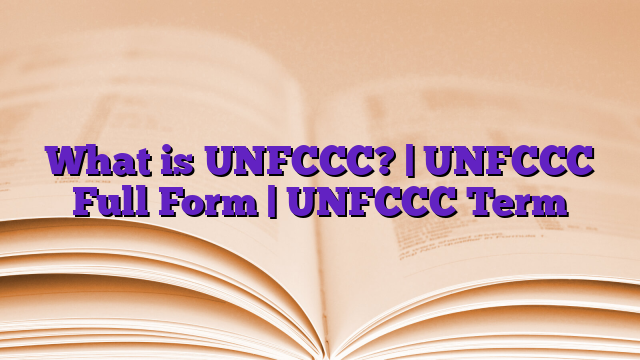What is YTD? | YTD Full Form | YTD Term
What does YTD mean? Discover its full form Year to

The United Nations Framework Convention on Climate Change (UNFCCC) is the UN process for negotiating an agreement to limit dangerous climate change. It is an international treaty among countries to combat “dangerous human interference with the climate system”. The main way to do this is limiting the increase in greenhouse gases in the atmosphere. It was signed in 1992 by 154 states at the United Nations Conference on Environment and Development (UNCED), informally known as the Earth Summit, held in Rio de Janeiro. The treaty entered into force on 21 March 1994. “UNFCCC” is also the name of the Secretariat charged with supporting the operation of the convention, with offices on the UN Campus in Bonn, Germany.
The convention’s main objective is explained in Article 2. It is the “stabilization of greenhouse gas concentrations in the atmosphere at a level that would prevent dangerous anthropogenic [i.e., human-caused] interference with the climate system”. The treaty calls for continuing scientific research into the climate. This research supports meetings and negotiations to lead to agreements. The aim is to allow ecosystems to adapt to climate change. At the same time it aims to ensure there are no threats to food production from climate change or measures to address it. And it aims to enable economic development to proceed in a sustainable manner.The UNFCCC’s work currently focuses on implementing the Paris Agreement. This agreement entered into force in 2016. It aims to limit the rise in global temperature to well below 2 °C (3.6 °F) above levels before the Industrial Revolution, and even aiming to hold it at 1.5 °C (2.7 °F). The Paris Agreement superseded the UNFCCC’s Kyoto Protocol which had been signed in 1997 and ran from 2005 to 2020.
By 2022, the UNFCCC had 198 parties. Its supreme decision-making body, the Conference of the Parties (COP), meets every year. Other meetings at the regional and technical level take place throughout the year. The Paris Agreement mandates a review or “global stocktake” of progress towards meetings its goals every five years. The first of these took place at COP28 in the United Arab Emirates (UAE) in 2023.
The treaty sets out responsibilities for three categories of states. These are developed countries, developed countries with special financial responsibilities, and developing countries. The developed countries are called Annex I countries. At first there were 38 of them. Annex I countries should adopt national policies and take corresponding measures to limit their emissions of greenhouse gases. They should also report on steps for returning individually or jointly to their 1990 greenhouse gas emission levels.
It is problematic that key signatory states are not adhering to their individual commitments. For this reason, the UNFCCC has been criticized as being unsuccessful in reducing greenhouse gas emission since its adoption. Parties to the convention have not agreed on a process allowing for majority voting. All decisions are taken by consensus, giving individual parties or countries a veto. The effectiveness of the Paris Agreement to reach its climate goals is also under debate, especially with regards to its more ambitious goal of keeping the global temperature rise to under 1.5 °C.
UNFCCC stands for United Nations Framework Convention on Climate Change. It is commonly used in industry/category/general. It is a widely recognized abbreviation/acronym used in various contexts.
UNFCCC or United Nations Framework Convention on Climate Change, finds applications in various fields such as relevant industries or general usage areas. It plays a critical role in specific function or value-add.
Knowing the full form of UNFCCC helps in understanding its importance in industry, field, or specific area. It enables better communication, deeper insights, and practical applications.
Knowing the full form of UNFCCC helps in:
Here are a few examples of how UNFCCC is typically used:
The full form of UNFCCC is An United Nations Framework Convention on Climate Change.
UNFCCC is used in industries or scenarios.
UNFCCC is important because it helps in specific function or benefit.
What does YTD mean? Discover its full form Year to
What does YMCA mean? Discover its full form Young Men’s
What does YAHOO mean? Discover its full form Yet Another
What does XMPP mean? Discover its full form Extensible Messaging
What does XML mean? Discover its full form eXtensible Markup
1992 politics in New York (state)1994 in the environmentAll articles with dead external linksAll articles with unsourced statementsArticles with dead external links from April 2018Articles with excerptsArticles with imported Creative Commons Attribution 4.0 textArticles with permanently dead external linksArticles with short descriptionArticles with unsourced statements from June 2021